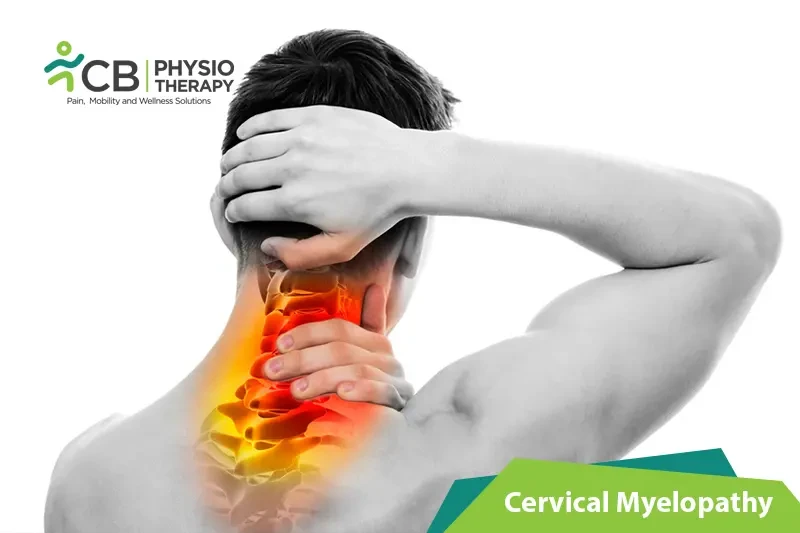
Cervical Myelopathy is the compression of the spinal cord at the cervical level. Cervical myelopathy occurs because of pressure on the anterior spinal cord due to deformation of the cord by anterior herniated discs, spondylotic spurs, spinal stenosis, and an ossified posterior longitudinal ligament.
The symptoms of Cervical Myelopathy usually develop slowly. Early symptoms of this condition include:
Cervical myelopathy arises when the spinal cord becomes compressed due to the wear-and-tear changes that occur in the spine. Common causes of cervical myelopathy are:
Pathology:
Cervical myelopathy arises when the spinal cord becomes compressed due to osteophyte or extruded disc material or wear-and-tear changes that occur in the spine. And encompasses a range of symptoms, including motor and sensory abnormalities related to dysfunction of the cervical spinal cord.
Physical examination:
The diagnosis of CSM is primarily based on a physical examination. Physical examination includes checking reflexes, muscle strength, or sensations, and range of motion of the neck.
Manual tests like the Distraction test, Spurling's test, +ve Clonus/Babinski/Hoffman's test can be done.
X- rays:
X- rays can be used to check for any bony problem like bone spurs, osteophytes, and other abnormalities.
CT scan:
CT scan helps to provide more detailed images of the cervical region.
Magnetic resonance imaging (MRI):
Magnetic resonance imaging (MRI) scan helps to locate the involvement of nerves, muscles, bones, tendons, and ligaments.
Myelogram:
Myelogram dye is used which gives a more detailed image and helps to make a proper diagnosis.
Nerve function tests:
A nerve conduction test is used to check the function of the nerves supplying the cervical area.
Electromyography:
Electromyography is used to check the function of the cervical muscles which is also helpful to make an appropriate diagnosis.
Medication: Muscle relaxants, Narcotics, Antiepileptic drugs, Steroid injections, non-steroid anti-inflammatory drugs (NSAIDs).
Note: Medication should not be taken without the doctor's prescription.
Surgery:
Surgery is required in patients with severe or disabling pain. Surgical techniques include:
Heat therapy or thermotherapy provides symptomatic relief by increasing the blood flow and decreasing pain.
Cryotherapy or Cold therapy is used to provide relief for muscles spasm.
Ultrasound therapy uses sound waves to oscillate the tissues at a frequency that increases blood flow and decreases inflammation.
Transcutaneous electrical stimulation:
Transcutaneous electrical stimulations (TENS) help decrease pain and spasm.
Traction therapy creates an anti-gravity, negative pressure to the cervical spine on the spinal disc, joints, nerves, and muscles, and thus reduces pain and stiffness.
Advanced high-energy pulses are effective for chronic neck muscle stiffness.
Massage therapy includes soft tissue release, deep friction massage, myofascial release, and trigger points release. Massage therapy uses appropriate pressure, to increase blood flow, reduce swelling, and provide relief from pain.
Manual therapy includes passive cervical joint mobilization, manipulation, and manual traction. These techniques reduce pain, and improve function by increasing the range of motion.
Dynamic exercises for the upper limb and lower limb are recommended. Range of motion exercises like neck flexion, extension, etc.
Stabilization exercises:
Vertebral segment stabilization of the cervical spine can be performed with a pressure biofeedback unit in case of anteroposterior instability of the vertebral bodies of a degenerative nature.
Strengthening and stretching exercises:
Strengthening and stretching exercises are recommended to regain the lost strength and flexibility of the neck muscles.
Proper posture:
Good posture should be practiced especially while using a computer or while reading or talking on the phone. The head and neck should be kept upright.
Proprioceptive exercises:
Proprioceptive exercises for the upper limb and the lower limb are also done.
Balance training:
The patient is asked to stand on one leg with eyes open and then with eyes closed, standing on a stable platform and then on an unstable platform with a rocker board.
The patient is advised to improve posture, do lifestyle modifications, and maintain the alignment of the neck during prolonged activities.
Select your City to find & connect with our experts regarding Physiotherapy for Cervical Myelopathy